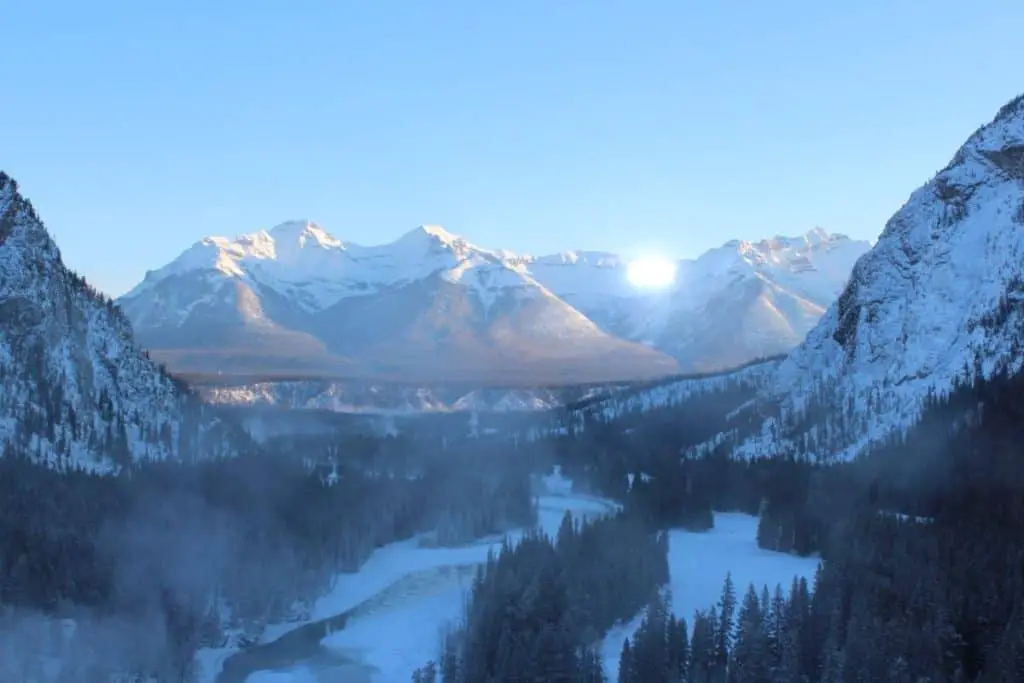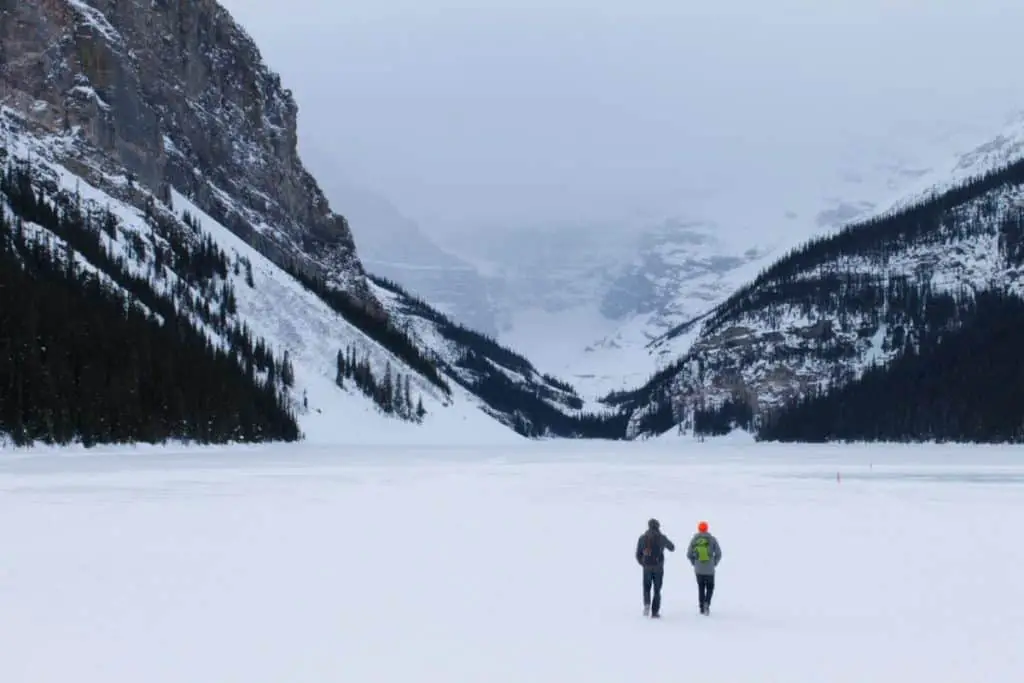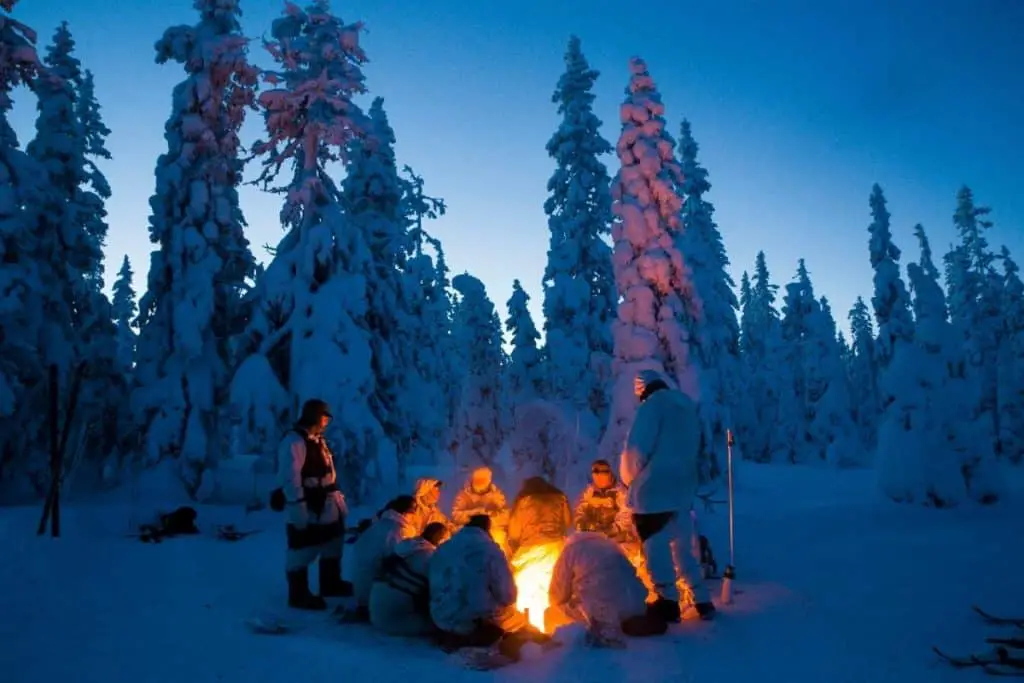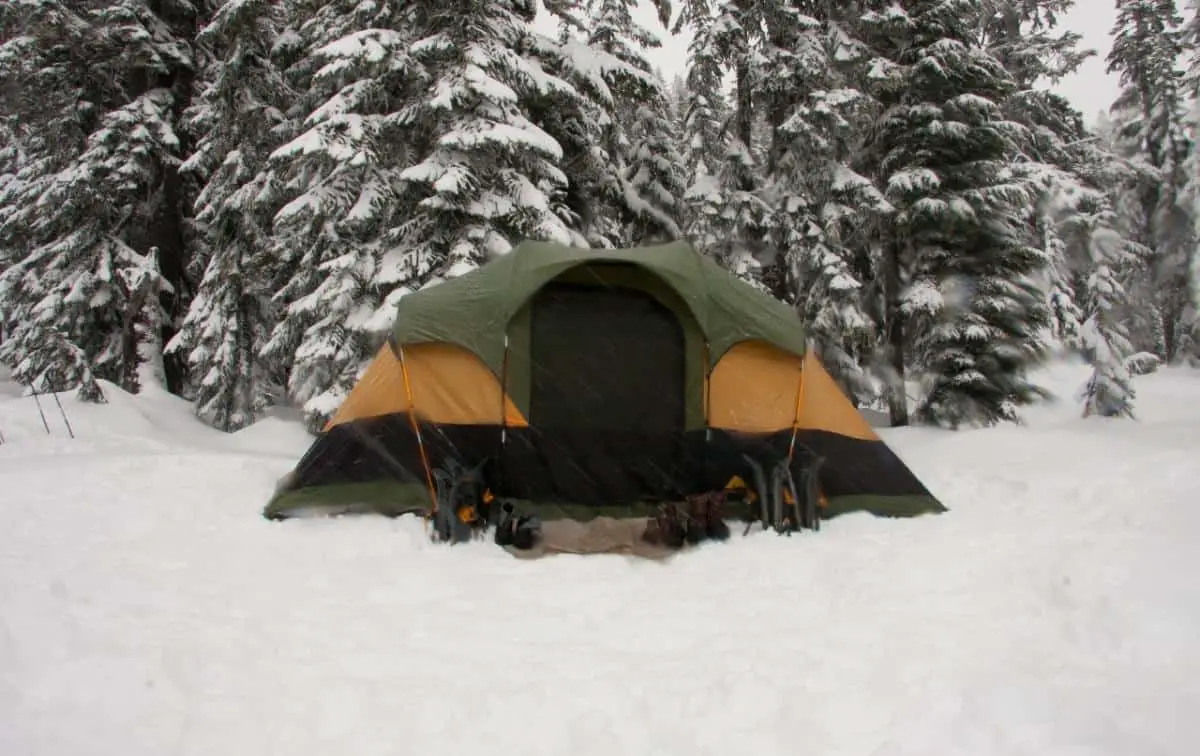Crazy about camping and want to enjoy the Rockies in Banff National Park in a different setting? Then go winter camping. Opportunities are limited, but the ones you have are worth it. In this guide, you’ll find everything you need to know about winter camping in Banff.
While camping in the Rockies might not sound too appealing to some, there are good reasons to do so. The most significant reason is the drastic change in the park’s look and outdoor opportunities due to the ubiquitous snow.
Banff National Park is like a whole different world in winter, and I dare say: just as beautiful. It’s absolutely worth checking out.
You probably already know. Otherwise you wouldn’t be reading this article. Let’s have a look at your camping possibilities in winter and what to take into account.
Where to Winter Camp in Banff?
Camping in Banff in winter is much more limited than camping in the park in summer. This is due to most campsites being closed and, depending on the conditions, there might be road closures.
That doesn’t mean there are no possibilities. Whether a tenter or an RVer, you can camp in Banff in winter. However, you have more winter camping opportunities in an RV than in a tent.

Tenting in Banff in Winter
If you plan on tenting in Banff in winter, there’s only one campground you can go to: Tunnel Mountain Village II. It’s open to tent camping year-round. While this being your only option in winter might be disappointing, the location is good.
This campground is only 3 kilometers (1.86 mi) from the town of Banff with all its facilities (shops, restaurants, bars) and is also close to the Sunshine Village and Norquay Mountain skiing areas.
RVing in Banff in Winter
Whether you want to go ski, snowboard or simply enjoy the magical winter scenery, winter camping in Banff National Park in an RV is a fantastic opportunity.
Two campgrounds in the park have year-round RV admittance. They both have facilities like electricity, water and toilets, making your stay comfortable (enough).
Though the cold could jeopardize some comfort. Pipes supplying water to RVs are susceptible to freezing on a campground and can even burst when temperatures fall well below freezing.
That’s one of the reasons most campgrounds are closed for the winter in Banff National Park. On the other hand, the ones that are open year-round (see below), have proper on-site maintenance, so there’s no need to worry about it much.
Winter Campgrounds for RVs
Below you’ll find an overview of the two campgrounds that allow winter camping for RVs and tents.
Lake Louise Trailer Campground
This massive campground has 189 sites, is well-equipped and is only 5.5 kilometers (3.4 mi) away from the Lake Louise ski resort. The lake itself, which is also stunning in winter and allows for ice skating, is only 4.6 kilometers (2.85 mi) away.
Lake Louise Trailer Campground
Address: 131 Fairview Drive, Lake Louise
Phone: +1 877 – 737 3783
Overnight stay: upon availability, reservations are possible
Number of sites: 189
Facilities: picnic tables, fire pits, cooking area, showers, flush toilets, handicapped accessible, electricity, and sani dump
Kind of accommodation: RVs
Price: from CAD 33.01 (subject to change)
Period: all year
Tunnel Mountain Village II
Regarding its location, Tunnel Mountain Village II is a perfect campground for your RV. It’s close to the town of Banff (only 3 kilometers, or 1.86 mi) with all the necessary facilities like shops, restaurants and bars.
There’s a Roam Transit bus stop close to the campground, so you can easily take public transport into town and taking a shuttle bus to the ski areas of Sunshine Village and Norquay Mountain is also possible.
Tunnel Mountain Village II
Address: Tunnel Mountain Road, Banff
Phone: +1 877 – 737 3783
Overnight stay: based on availability, reservations possible
Number of sites: 209
Facilities: camp kitchens, picnic tables, fire pits, firewood, showers, flush toilets, handicapped accessible, sani dump
Kind of accommodations: RVs and tents
Price: From CAD 33.01 (subject to change)
Period: all year
Bus stop: Roam Transit
Want to know how many front-country campgrounds Banff National Park has to offer? Click the link and find out.
What about Backcountry Camping in Winter?
Yes, you can also do backcountry camping in Banff in winter, as these campgrounds operate all year. Before pitching your tent on a backcountry campground, you must make an online reservation at the Parks Canada website.
What to Bring for Winter Camping?

Recommended reading: 2022-2023 Banff Ski Resorts Comparison
If you’re planning a camping trip in Banff during the winter, knowing what to pack is crucial. Temperatures can be brutal, depending on the month you visit the park.
Here are the average temperatures from November to March, so you’ll know what to expect. Please keep in mind that these temperatures are averages, and the weather you’ll experience can be vastly different. I experienced -21˚C (-5.8˚F) in November!
| HIGH | LOW | |
|---|---|---|
| November | 0.1˚C (32.2˚F) | -8.1 (17.4˚F) |
| December | -5.2˚C (22.6˚F) | -13.3˚C (8.1˚F) |
| January | -3.1˚ (26.4˚F) | -12.2˚C (10.0˚F) |
| February | High: -0.2˚C (31.6˚F) | Low: -11.0˚C (12.0˚F) |
| March | High: 5.2˚C (41.4˚F) | Low: -6.6˚C (20.1˚F) |
Looking at the number above, we can conclude that December is the coldest of the selected months and March is the warmest.
How to Dress for Winter Camping
Make sure you bring lots of warm clothing and wear multiple sweat-wicking layers to keep you dry. Your coat should be windproof. A parka is probably your best bet. It allows you to stay warm at all times, even when standing still for a long time. Wearing a fleece sweater and a thick long-sleeve T-shirt underneath is a good choice.
Also, bring long underwear, at least two pairs of snow pants, and moist-wicking socks to keep your feet dry.
Also make sure your footwear is adequate for the circumstances. Take warm, insulated (hiking) boots. Your average sneaker or everyday shoe won’t cut it. A pair of gaiters could be handy as they prevent moisture from entering your boots.
And, of course, you’ll also need gloves and mittens and a (woolen) hat that can cover your ears (bring two; if one gets wet, you’ll have a spare one).
Gear for Winter Camping
- Sunglasses
- Goggles
- Sunscreen
- Flashlight
- Sleeping bag (make sure it’s suited for temperatures well under zero degrees Celcius, check the product info carefully before buying)
- Comfortable backpack (to store extra clothing, food and drinks on a trip)
- Microspikes (also known as Yaktrax) for hiking
- Satellite phone (for when you’re lost in the cold because you’ll have no cell signal in most places)
- First-aid kit
- Lip balm
- Physical map (it will never run out of battery power!)
Where to Rent Winter Camping Gear?
Maybe you forgot some to bring along, or you just don’t want to invest in all the stuff you need for winter camping in Banff.
Or you want to engage in an activity and need some gear. In Lake Louise, Banff and nearby Canmore, you can rent lots of winter gear. Below you’ll find some shops and their details.
LAKE LOUISE
Wilson Mountain Sports
Address: Building A Samson Mall, 101 Lake Louise Drive
Phone: +1 403 522 3636
Website: wmsll.com
E-mail: info@wmsll.com
BANFF
Snowtips Bactrax
Address: 225 Bear Street
Phone: +1 403 762 8177
Website: snowtips-bactrax.com
E-mail: snowtips@telusplanet.net
Ultimate Banff
Address: 206 Banff Avenue
Phone: +1 403 762 0547
Website: ultimatebanff.com
E-mail: retail@ultimatebanff.com
White Mountain Adventures
Address: 137 Eagle Crescent
Phone: +1 403 – 760 4403 Ext 21
Website: whitemountainadventures.com
E-mail: info@whitemountainadventures.com
CANMORE
Gear Up
Address: 1302 Bow Valley Trail
Phone: + 1 403 678 1636
Website: gearupsport.com
E-mail: info@gearupsport.com
Can You Build a Campfire in Winter?

It’s possible to build a campfire in Banff National Park in winter. However, Parks Canada requires you to use the provided metal fire rings or boxes. Before creating a campfire, you must obtain a fire permit. You can get them at the reception of a front-country campground or the Banff or Lake Louise Visitor Centre.
Parks Canada also requires you never to leave a campfire unattended and to ensure you properly extinguish the fire with water, using the soak-stir-soak method until it’s thoroughly cooled.
If you’re interested in building a campfire, you might want to check out the Comprehensive Guide to Barbecueing in Banff.
Are There Dog-Friendly Winter Camping Spots?
Dogs are allowed on campgrounds in Banff National Park all year. However, they must be kept on a leash to prevent harming smaller animals and aggressive behavior from wildlife in the park. You must also clean up your dog’s waste and put it in a garbage can.
In general, you can take them with you on all trails. Parks Canada advises leaving your dog at home if you go backcountry camping. Also, your dog may not be allowed on some trails. Check the closures and restriction section on the Parks Canada website to find out what trails this applies to (if at all).
What Wildlife Can You Spot in Winter?
While bears are known to retreat to their dens to hibernate (which means you usually wouldn’t see a bear in Banff in winter), plenty of other animals are active in the coldest months.
These include wolves, lynxes and wolverines and mountain lions (cougars). But it’s extremely rare to spot any of these. Even in summer.
Winter sightings of moose, coyote and mountain goats are rare.
Wildlife you’re more likely to spot are bighorn sheep, elk and deer.
If you run into any of these, the same rules apply as in summer: Don’t get too close and never feed them. If you see predator tracks in the snow, deviate or turn around. Don’t follow its tracks.
Winter Camping Risks
The significant differences between camping in Banff in summer and camping in winter are the weather (circumstances) and the snow. These two come with challenges when you’re winter camping.
- The most obvious one is the cold which can be dangerous in different ways.
- With temperatures well below zero, you must take the necessary precautions to stay warm. If not, you’re at risk of getting hypothermia (dropping body temperature) or even freezing to death. Preventing this is not too difficult; just make sure you bring proper clothing and a suitable sleeping bag (see the paragraphs about How to Dress for Winter Camping and Winter Camping Gear above).
- If you’re not warmly dressed, you risk frostbite. This happens when body areas are exposed to freezing temperatures or strong winds.
- Dehydration. It might sound strange in winter because there’s no sweltering sun to make you sweat. Still, you might sweat a lot when you engage in a high-effort activity. But the cold makes you less likely to notice it and you don’t drink as much as you should. It could cause a dry mouth, increased heart beating and dizziness. The remedy is simple: drink water.
- Snow provides hazardous circumstances in different kinds of ways.
- First off, it makes for risky driving on your way to the park, or driving through the park. Explaining what’s involved with that requires a whole different blog post, which you can find here: Your Go-to Guide to Winter Driving in Banff National Park.
- Secondly, roads are slippery, not only for road vehicles but also for you as a pedestrian. Before you know it, you’ll slip and injure yourself.
- Snow also makes for heavy hiking or other winter activities. It demands a certain fitness level as you’ll get exhausted much easier. This goes for pretty much all outdoor winter activities.
- Thirdly, snow causes avalanche hazards. That’s why the road to Moraine Lake is always closed in winter.
- Heavy snow can make you suffer from complete disorientation.
- Snow can cause snowblindness. It results from too much UV light reflected off snow and ice and gives a gritty sensation to the eyes. It’ll make your eyes (temporarily) more sensitive to light and you might see halos around light sources.
Recommended reading: Sledding in Banff – Opportunities and Possibilities.

